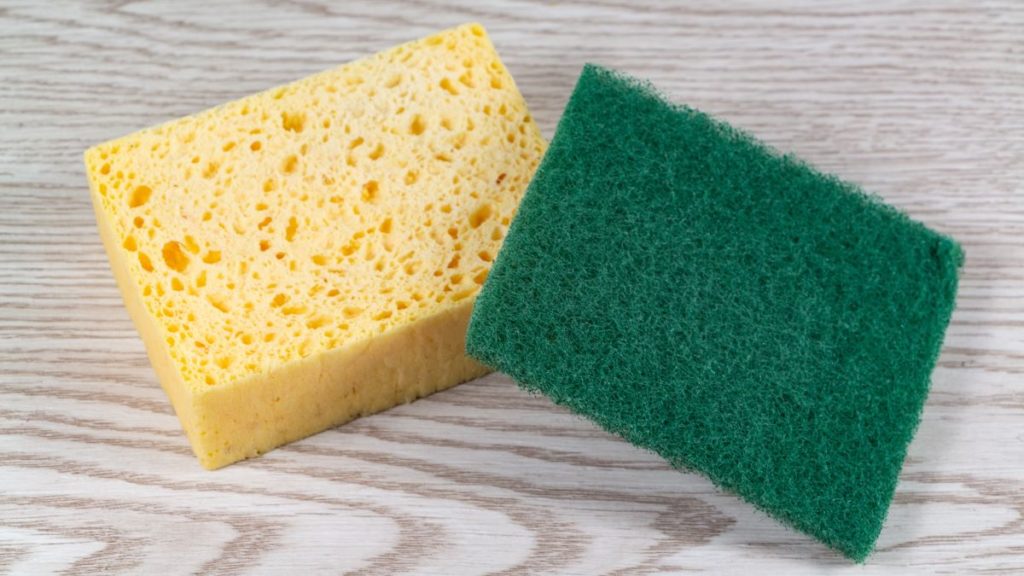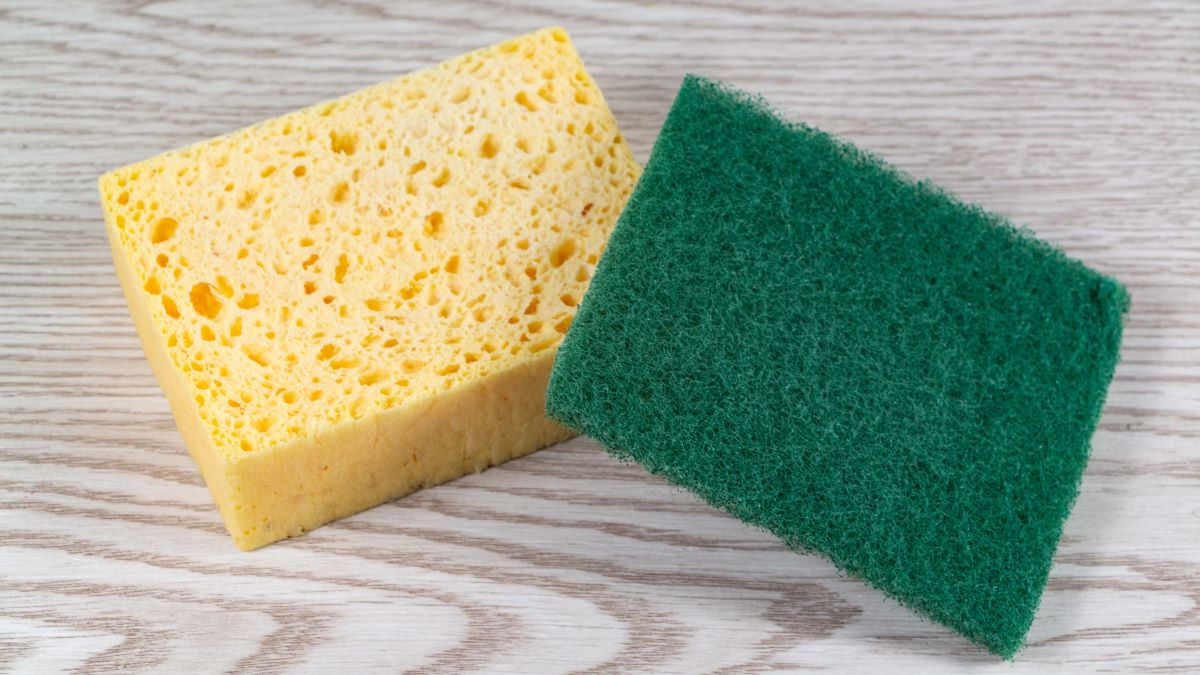
Recycling Mystery: Kitchen Sponges and Scouring Pads

When you are stuck scrubbing a pan with baked-on grease, you know what a help sponges and scouring pads can be. There’s only so much elbow-grease a person can expend on a single pan.
Yet, the sponges and scouring pads you find in most stores pose a host of environmental problems — from manufacture to disposal. How can we use these kitchen workhorses without trashing the planet? Luckily, there are lots of eco-friendly alternatives to typical kitchen sponges.
This article contains affiliate links. If you purchase an item through one of these links, we receive a small commission that helps fund our Recycling Directory.
The Problem With Kitchen Sponges
What’s so bad about regular kitchen sponges and those flat rectangular scrub pads? Quite a few things, actually.
Sponges Are Made From Plastic
The bright green and yellow sponges you see in your grocery store aisles are typically made from plastic. According to The Center for International Environmental Law’s report Plastic & Climate: The Hidden Costs of a Plastic Planet, manufacturing and incinerating plastic produced more than 850 million metric tons of greenhouse gases in 2019 alone.
Sponges Are Frequently Replaced
Sponges do a lot of disgusting jobs for us, and they can be magnets for germs. Because they are nasty and germ-ridden, researchers recommend tossing the stinkers every week. That’s problematic.
If 1 million households toss one sponge a year, that’s 1 million sponges sitting in landfills or being incinerated. If 1 million households toss out one sponge per week, that’s 52 million sponges. With more than 122 million households in the United States, that adds up to a staggering amount of plastic trash.
Sponges Create Microplastic Pollution
When you wash your dishes with a sponge, it sheds tiny fibers. These fibers, a type of microplastics, can’t be filtered out by water treatment plants. These end up in the ocean where they join the millions of metric tons of plastic dumped there every year.
Options for Recycling Sponges
Unfortunately, kitchen sponges and scouring pads aren’t easy to recycle. Like a lot of plastic consumer goods, you can’t throw them in curbside recycling.
TerraCycle creates mail-in campaigns for hard-to-recycle items. A review of their website reveals only one such campaign for recycling sponges, currently, which accepts only one brand of sponge. (They do update their recycling campaigns periodically, so you might want to check back.)
Natural Alternatives to Plastic Sponges
Given the environmental issues of plastic sponges, it’s best to look for sponges and scrubbers that are made of natural materials. The good news is there are a ton of affordable alternatives.
Be on the lookout for greenwashing, though. Manufacturers can use terms such as “eco-friendly,” “all-natural,” and “nontoxic” pretty loosely, so it helps to do some research. Here are some plastic-free options.
Fabric Dishcloths
Long before anyone made sponges from fossil fuels, people used a cloth to wash their dishes. Now, eco-conscious consumers are returning to this simple option.
Full Circle makes organic cotton dishcloths that are stitched with loops that help with removing stuck-on food. Use these for dishwashing and/or to wipe down countertops. Whiffkitch dishcloths are made of bamboo rayon, although the colored edging is synthetic.
You can also cut up old clothing or towels to replace your sponges — natural fibers like cotton and linen tend to work best.
Unsponges
Unsponges are a popular alternative to regular sponges. Etsy has over 2,400 results for the term unsponge. Most of these are made of cotton, but many are covered in nylon mesh or stuffed with recycled plastic. Unsponges with natural fiber stuffing and coverings are available — you just have to read the fine print.
You can also find a variety of sponge alternatives on Amazon, including MioEco’s 100% organic cotton unsponge (the filling is also organic cotton) for non-scratch cleaning and KOLO Nature’s 100% hemp scrubber sponge.
Cellulose Sponges
Cellulose sponges are primarily made from wood fiber. Not all sponges labeled as cellulose are 100% natural plant fibers, though. Many are mixed with plastic. Also, some 100% cellulose sponges are soaked in chemicals.
rE: makes 100% plant-based cellulose sponges that are fully biodegradable. If You Care’s washable sponge cloths are 70% cellulose and 30% cotton.
Loofah Sponges
You know how well a loofah works in the shower. Who says you can’t use the same kind of sponge on your dishes? Some companies even offer loofah kitchen sponges cut to a convenient size.
If you really want to go all out, you can grow your own loofah (Luffa acutangular) plant. The center of the loofah gourd is the part we use as a sponge. This article explains how to grow and harvest the loofah. (Note: Loofahs are easiest to grow in warm climates with long growing seasons.)
Coconut and Walnut Scrubbers
You can replace your plastic scouring pads with plant-based scrubbers. Grove Collaborative has a selection of coconut and walnut scrubbing pads. Since they are 100% plant-based, you can add them to your home composting bin when they’re worn out, as long as they are not drenched with fats and oils.
A Clean Kitchen and a Healthy Planet
Keeping your kitchen clean doesn’t have to result in trashing the planet. There are plenty of eco-friendly sponges, unsponges, and scouring pads on the market. These earth-friendly options can help you keep a clean kitchen and a clean planet.
Originally published on January 4, 2021, this article was updated in September 2022.